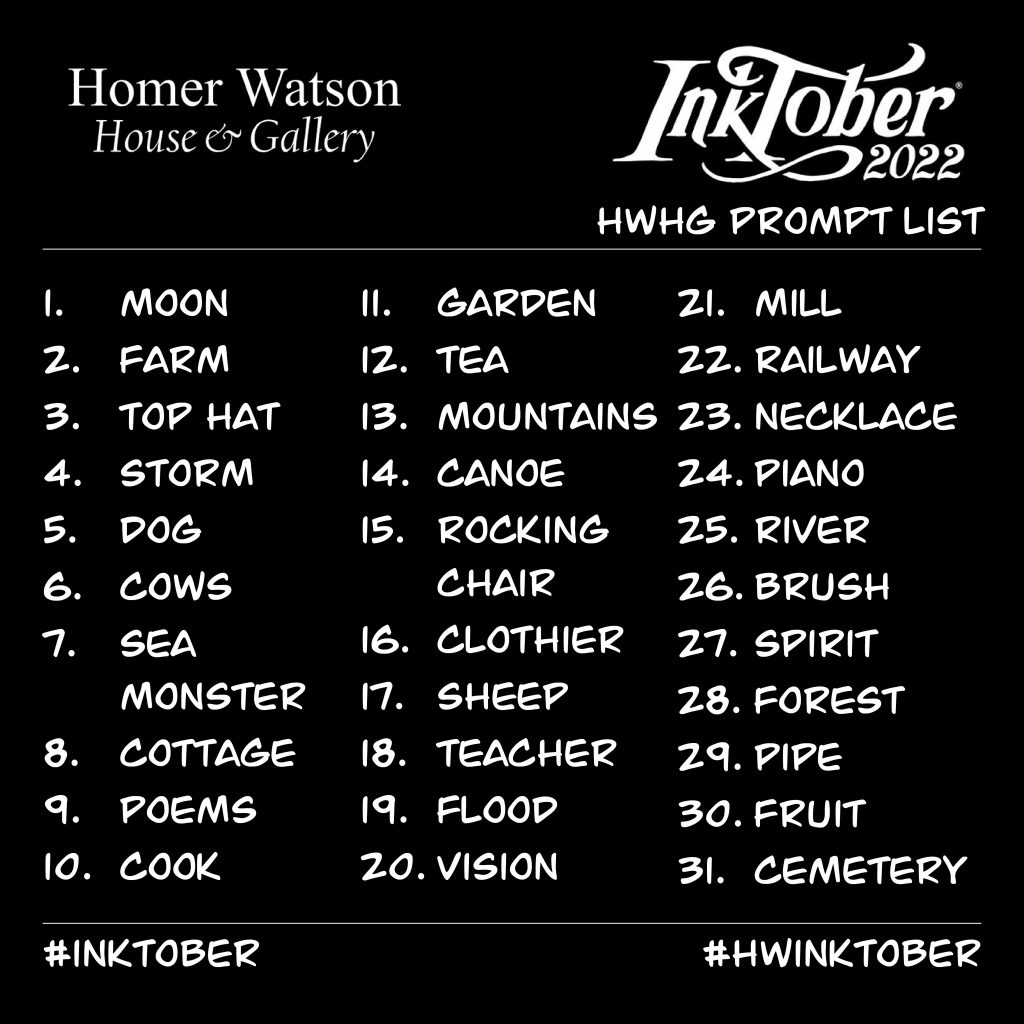INKTOBER 2022
Inktober is a world-wide challenge to help you improve your drawing skills. Each year a new “prompt list” is posted with a different word each day to guide you in your daily creation. It doesn’t need to be big, or fancy, just fun and a stress-free as possible. The rules are simple, pick up a pen (or marker, or brush, or anything ink related), and draw. No skill required – you can even draw with your toes if you really want to.
Here at the Gallery, we have created our own “prompt list” with words relating to Homer Watson, his sister Phoebe, and their history. Feel free to join in on the fun. You can draw everyday, or just pick and choose which days you want to draw. We will be posting artwork of any participants (including some of our staff) here on this webpage, so make sure to visit often.
If YOU would like to participate, post your image online and tag us with #hwinktober or send your image to graphics@homerwatson.on.ca.
(Don’t forget to include your name or IG handle)
To learn more about the Official Inktober rules, visit their website here.
Oct 1 - Moon
The shining moon in Homer Watson’s nocturnes offers a sense of mysteriousness.
Oct 2 - Farm
Doon was a very rural area during Homer Watson’s life. He was very interested in capturing the ways that humans interacted with nature – so farmland, fields, and harvests are all subjects that appear in his paintings.
Oct 3 - Top Hat
Homer Watson’s top hat was most likely purchased in England, and has a maker’s mark from the company Henry Heath Ltd. It would have been worn on formal occasions and is embossed with the initials “HW” in gold.
Oct 4 - Storm
Homer Watson believed that nature was a powerful force that should be respected. This belief is reflected in his many paintings of stormy scenes.
“Another rumble and the storm was upon me. I packed my kit and started toward the mill. The thunder boomed along the black horizon. Strident detonations rolled grandly out and shook the vault of heaven.” – Homer Watson
Oct 5 - Dog
Homer’s little white dog named Terry followed him around Cressman’s Woods, the studio, and all over Doon. The pup was also photographed getting plenty of cuddles from Mary Watson.
Oct 6 - Cows
It’s easy to find cows dotting the landscapes of Homer Watson’s paintings – grazing, watering in rivers, and laying in the fields.
“In the village of seven dams many were the stories that went around about Homer ‘sittin’ in the house paintin’ nothin’ but the backsides of cows while other people worked’”. – Jane Van Every.
Oct 7 - Sea Monster
In the 1920s, there once was a legend of the “Sea Monster of Doon”, where many residents of the village spotted what appeared to be a snake-like creature floating down-river. It turns out that after much bickering, it was discovered the monster was actually bits of run-off from a local mill.
Oct 8 - Cottage
Phoebe Watson had a cottage on Lake Huron, in Oliphant Ontario. She often took trips there to paint watercolour landscapes and brought her art students to practice there as well.
Oct 9 - Poems
Many poems were written about Homer Watson, and many of his works were inspired by his favourite works of poetry. Phoebe Watson was a poet herself, and often wrote them for her friends.
Oct 10 - Cook
Roxa Watson’s family and guests were fans of her cooking. She provided many delicious meals at gatherings.
“Aunt Roxy was a lovely hostess and a very good cook. Uncle Homer always stood to carve at the head of the table, and Aunt Roxy served vegetables at the other end of the table.” – K. Fromm
Oct 11 - Garden
Phoebe Watson was a lover of plants and flowers. She grew a variety of them in her garden and was even said to have set up her flowerbeds in the shape of an artist’s palette.
Oct 12 - Tea
Phoebe Watson held many parties at the Watson House, many of which were tea parties. She not only enjoyed being a hostess, but also painted her own designs onto porcelain tea sets – including teacups, milk pitchers, and sugar bowls.
Oct 13 - Mountains
Homer Watson’s travels took him to both the Adirondack mountains in New York and out to the Canadian west to see the Rockies. Though trees are perhaps his favourite subject in nature, his mountains are majestic as well.
“Those mountains bowled me over. I hope my age and creaking heart muscles don’t throw the ideas out when I start those pictures.” – Homer Watson
Oct 14 - Canoe
As a member of the Grand River Canoeing Club, Homer Watson took many trips out on the water. His official role in the club was as the “Vice Commodore”.
Oct 15 - Rocking Chair
The wicker rocking chair on display in the Watson Studio was likely owned by Phoebe Watson. There are many photographs of Homer lounging in a rocking chair, and Phoebe often depicted her mother knitting while seated in one in her artwork.
Oct 16 - Clothier
Phoebe was a woman of many talents. Beyond being an artist, poet, and teacher, she also worked for a time as a seamstress and dressmaker.
“Oh Roxa when I read about you thinking of sending me a green dress it made me smile as I have two over. I made my old green silk over with watered silk in a lighter shade […]” – Phoebe Watson
Oct 17 - Sheep
Sheep are another animal which are often found roaming around Homer Watson’s landscapes. When Watson travelled in England, he wrote to the Marquis of Lorne, who he had sold a painting to earlier in his career – asking if he could touch up the sheep in the piece.
“I hope to get up to your studio to thank you for your ‘transmogrification’ of the sheep. They look much better, and are very proper sheep now with all the stiffness taken out of them, and lots of wooliness put in!” – The Marquis of Lorne
Oct 18 - Teacher
As a boy, Homer Watson got in trouble at school for drawing caricatures of his teacher Mr. Burkholder.
Oct 19 - Flood
A disastrous flood that broke the dam of the Doon Mills was the inspiration for Homer Watson’s The Flood Gate, which is considered to be one of his greatest works. The flood was so powerful that Adam Ferrie, who owned the mill at the time, referred to it as “The Judgement of God”.
Oct 20 - Vision
Homer Watson recalls seeing a vision of the ghost of his wife Roxa after she passed.
Oct 21 - Mill
Mills frequently appear in Homer Watson’s artwork. One of his most famous pieces, The Pioneer Mill, was inspired by his grandfather’s sawmill.
“He would stand for hours watching the water rush over the dam, noting the whiteness of the foam, then go back to his painting.” – Jane Van Every
Oct 22 - Railway
The Doon Train Station was where the Watsons most often started their journeys. Toronto was a frequent stop, where Homer held many exhibitions and Phoebe took art classes.
Oct 23 - Necklace
On their 25th anniversary, Homer Watson had a necklace made for his wife Roxa.
Oct 24 - Piano
Homer Watson was apparently a musician as well as an artist. A piano was said to sit in their living room, which Homer apparently played until his hearing left him.
Oct 25 - River
The Grand River was a great inspiration to Homer Watson. He didn’t just create many paintings of it, but also made several canoeing trips across its waters.
Oct 26 - Brush
Homer Watson used many different types of brushes and brush techniques in his paintings. His artistic style changed over the course of his life, from small and detailed brush strokes in his early works to the heavy impasto of his late period.
Oct 27 - Spirits
As a practitioner of Spiritualism, Homer Watson participated in seances where he attempted to communicate with the spirits of the deceased.
Oct 28 - Forest
Homer Watson loved trees. When Cressman’s Woods was threatened with sale to the owner of a sawmill, Homer and a group of like-minded individuals gathered together to buy it instead – wanting to preserve its natural beauty. Today, Cressman’s Woods is known as Homer Watson Park.
Oct 29 - Pipe
In several photographs and in a portrait painted by Phoebe, Homer can be seen smoking using a pipe.
Oct 30 - Fruit
Phoebe Watson grew more than flowers in her garden and had many fruit trees. She grew apples, pears, plums, and grapes.
Oct 31 - Cemetery
The Doon Presbyterian Church was built in 1854, and part of the Christian Schneider farm was purchased for use as a community cemetery. Homer Watson and many of his family members are buried there, as well as several interesting figures from the history of Doon.












